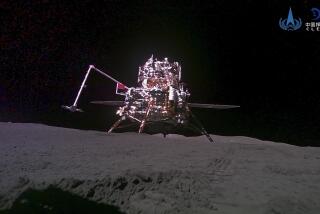Welcome home, Tiangong-1: China’s wayward space lab has returned to Earth
- Share via
China’s defunct space laboratory has returned to Earth, with pieces apparently splashing down in the Pacific Ocean off the coast of South America.
Tiangong-1 reentered Earth’s atmosphere at about 5:16 p.m. Pacific time on Sunday, according to the U.S. Strategic Command’s Joint Force Space Component Command.
Officials at the command had been closely monitoring the wayward space lab, along with their counterparts from Australia, Canada, France, Germany, Italy, Japan, South Korea and the United Kingdom. The spacecraft weighed 18,740 pounds and was about the size of a school bus.
“The JFSCC does not predict or track what happens after decay and reentry occurs, such as the exact location of fallen debris on the earth’s surface,” the command said in a statement issued Sunday.
A map provided by the Aerospace Corp. predicted that Tiangong-1’s reentry occurred in the southern hemisphere off the coast of Chile.
Tiangong, which means “heavenly palace,” stopped communicating with Chinese officials in March of 2016. At that point, it had spent 1,630 days in operational orbit — about 2.5 years longer than the two years initially planned for its mission.
The craft was China’s first orbiting space laboratory. It was launched in 2011 and docked with three Chinese spacecraft.
Experiments aboard Tiangong-1 were related to space technology and exploration, according to China’s manned space engineering office.
The space lab’s descent had been closely watched by government officials, aerospace experts and amateur satellite trackers since 2016. They expected most of the craft to burn up in the atmosphere, but 10% to 40% of it could have survived and landed on the planet’s surface.
Chinese officials initially expected their craft to reenter the atmosphere in late 2017. They revised their timeline in December, telling the United Nations that Tiangong would likely return to Earth in February or March.
China’s space program aims to have a permanent manned space station in orbit by 2022.
Follow me on Twitter @LATkarenkaplan and “like” Los Angeles Times Science & Health on Facebook.
MORE IN SCIENCE
Yes, a Chinese space station is about to plummet to Earth. Here’s why you don’t need to freak out
InSight: NASA’s next mission to Mars will go deep beneath the red planet’s surface
These monkeys surprised scientists by sharing even more when no one was looking







